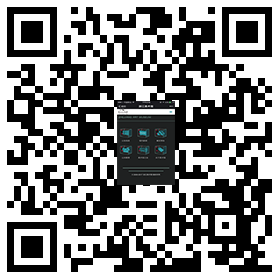Successful Opening Ceremony of “Pad Dimension” and Academic Dialogue Unveil a Visual Landscape from Graph to Virtual
pubdate: 2021/3/30 author: zjam source: zjam click:
On March 28, 2021, “Pad Dimension: Visual Art from Graph to Virtual”, a project included in “Support Program of the Ministry of Culture and Tourism for Young Curators from Art Museums in China for 2020”, was officially opened in Hall No.1 and No.2 of ZJAM under the guidance of Zhejiang Association for Science and Technology (ZAST) and sponsored by ZJAM.
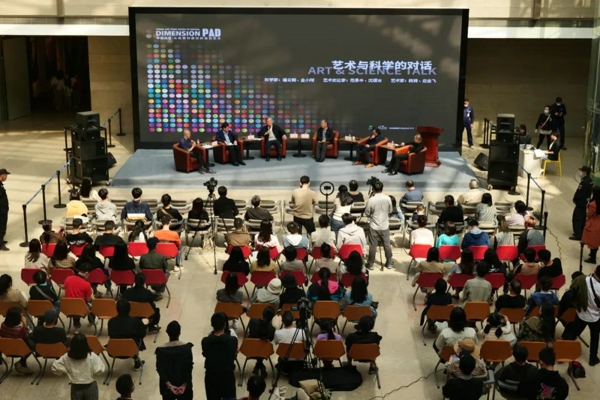
At the opening ceremony
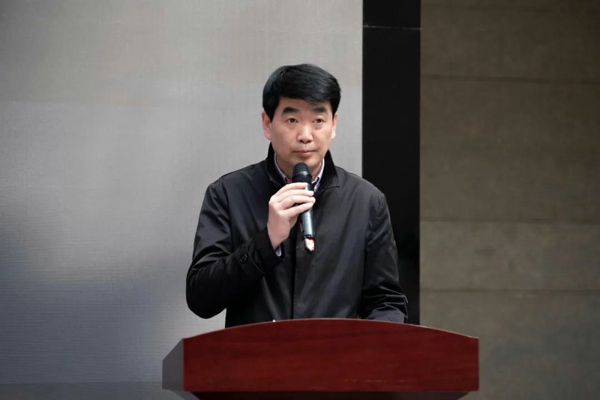
Qian Cheng, deputy curator of ZJAM, presiding over the signing ceremony
Art museum exhibitions are mechanisms to generate cultural meanings, fields to share social landscape, and ontological modes to get truths. In order to fully explore the social value and aesthetic significance of the integration of art with scientific technology, this opening ceremony was launched in the form of an academic dialogue. This classic dialogue about art and scientific technology, approached from the contemporary language characteristics of drawing on pad, was joined by six well-known representatives with outstanding achievements in the fields of science, art history and art theories, and art profession: Professor Pan Yunhe, an academician and former executive vice president of the Chinese Academy of Engineering, and former president of Zhejiang University, Professor Fan Jingzhong, a doctoral supervisor of China Academy of Art (CAA), Professor Jin Xiaogang, a doctoral supervisor of the State Key Laboratory of Computer-Aided Design and Computer Graphics (State Key Lab of CAD-CG), Zhejiang University, Professor Chen Qi, executive deputy dean and doctoral supervisor of the Graduate School of the Central Academy of Fine Arts, Professor Shen Yubing, doctoral supervisor of the School of Philosophy and director of Art Philosophy Research Center, Fudan University, Ying Jinfei, curator of ZJAM and professor of CAA. At the same time, Professor Zhou Xiaoying of CAA, Mr. Wang Guangnian, director of Science Popularization Department of ZAST, Professor Chang Qing, president of Zhejiang Oil Painting Academy and doctoral supervisor of CAA, Professor Sun Lingyun, deputy dean of the International Design Research Institute of Zhejiang University, Professor Xue Feng, deputy dean of the School of Media, Nanjing University of the Arts, and Li Qing, a teacher of CAA, attended the event. The opening ceremony was presided over by Qian Cheng, deputy curator of ZJAM.
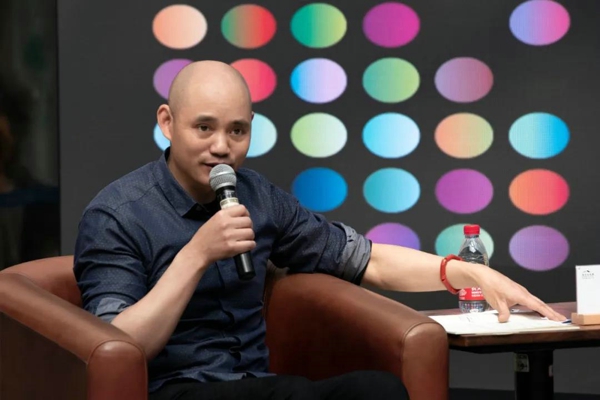
Curator Ying Jinfei delivering a speech at the dialogue
“The Dialogue between Art and Science” was presided over by Ying Jinfei, curator of ZJAM. Curator Ying first welcomed all the guests and audiences. He said that this year marks the centenary of the founding of the Communist Party of China and also the first year of the “14th Five-Year Plan” period. The digital reform conference held by the Zhejiang Provincial Party Committee at the beginning of this year rang the call for building a “Digital Zhejiang” in an all-round way. In recent years, ZJAM has always adhered to the “Zhejiang Spirit” that advances with the times and has assumed the responsibility of leading art development in Zhejiang by implementing different cultural strategies in response to national development strategies and by continuously promoting diverse, inclusive and comprehensive exhibition ideas. The exhibition of “Pad Dimension”, as an exploratory exhibition of ZJAM to aim for the new century, reveals many possibilities from the integration of scientific technology and art with a forward-looking vision and an avant-garde spirit. It can better repay the society and enhance the close connection between reality and virtuality in exploring a digital reform.
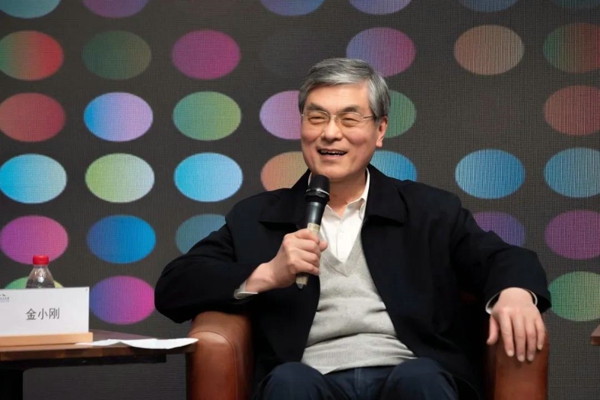
Academician Pan Yunhe delivering a speech
In his speech, Academician Pan Yunhe began with recalling the use of computers to design art patterns 38 years ago. In his opinion, it was not until today that he finally saw an exhibition using pads as a medium at ZJAM, and this exhibition thus was a milestone in the art development history in Zhejiang. In addition, he explained the importance of the integration of art with scientific technology from three aspects. Firstly, pad has become a new tool in the mainstream art world. It can be used to create not only oil paintings, sketches, prints and Chinese paintings, but also other art genres. Arguably, it is a new powerful tool in the art world. After using this tool, artists will find infinite charm in it. Secondly, the combination of the art world with computer will announce the birth of “digital art” as a new type of painting. “Digital art” will be used mainly to simulate oil paintings, traditional Chinese paintings, and watercolors in the first place. As artists get familiar with it, they will push this type of painting towards a more promising direction. Thirdly, we are now entering a new era when the Zhejiang Provincial Party Committee and Provincial Government has proposed the digital reform, and ZJAM is taking an important step with this exhibition. In addition, the combination of art with scientific technology also puts forward new requirements for theoretical development. In the field of cognitive science, in particular, more scholars are needed to promote the development of artistic cognition. Moreover, Academician Pan suggested that ZAST and the Zhejiang Federation of Literary and Art Circles join hands to carry out various creative activities enabled by digital technologies in the name of “digital creativity”. At present, “digital creativity” has become an industry with nationwide output value of RMB 8 trillion. Therefore, the integration of art with scientific technology will not only fuel the development of both fields, but also promote the development of related industries.
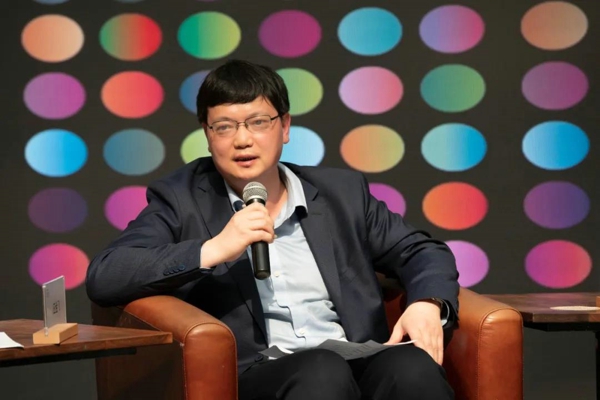
Professor Jin Xiaogang delivering a speech
Professor Jin Xiaogang gave a detailed introduction to the concept, characteristics and practical application of “virtual reality” based on the research projects undertaken by the State Key Lab of CAD-CG, Zhejiang University, in recent years. He believed that virtual reality is a created and experience-based computer simulation virtual world that uses computer to generate a digital environment that is highly similar to the physical world in terms of sight, hearing, and touch. Users interact and influence with digital objects in the digital environment through natural human-computer interaction to have an immersive real experience. An outstanding feature of virtual reality is the duality of virtuality and reality. Physically speaking, virtual reality does not exist, but in the user’s sensory world, it is real and can be perceived through sight, hearing, touch, and force. It has characteristics of immersion, interactivity and conception. Professor Jin also cited the example of “VR Sketch Fireworks at the Asian Games” created by the State Key Lab of CAD-CG for the Hangzhou Organizing Committee to vividly portray a practical application scenario of virtual reality technology.
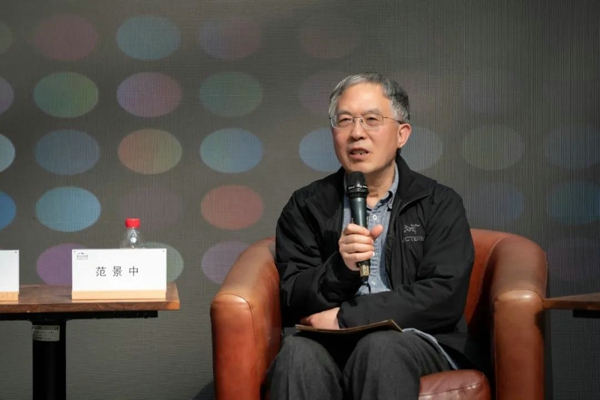
Professor Fan Jingzhong delivering a speech
Professor Fan Jingzhong traced the relationship between art and science from the scholarly perspective of art history. He believed that artists in different periods tend to embrace science because they can benefit from the huge changes brought about by science. Taking the artists of the Western Renaissance as an example, they introduced the principle of “maths” and a series of science-related concepts or scientific methods such as perspective, proportion, and anatomy into artistic creation. As proven by Leibniz’s “pre-established harmony” theory, whether it is realized or not, the movement of the universe involves a pre-established rhythm of harmony and perfect proportions. Therefore, cosmologists in the Renaissance dominated the fields of science, art, and philosophy while pursuing truth, and Leonardo da Vinci was one of the most important representatives. The image world plays a tremendous role in shaping modern civilization and modern science. The grand blueprint of art has always cared for science, and artists have made great contributions to science. Only when the world of art is integrated with the world of science, will the world be complete.
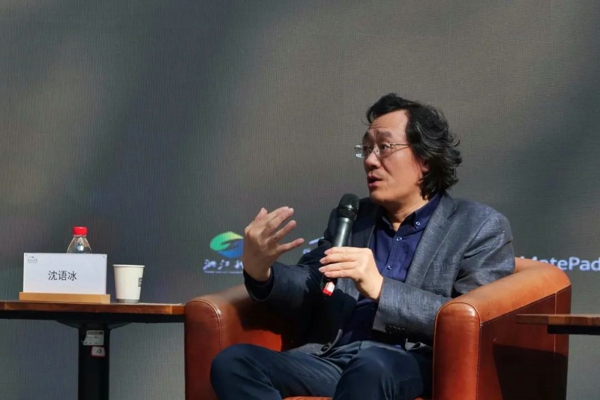
Professor Shen Yubing delivering a speech
Continuing the topic above on Renaissance and Neo-Platonism, Professor Shen Yubing mentioned that Einstein’s theory of relativity and modern physics allowed people to understand the world from a new perspective. At this point, art moved from classics to the prosperous modern period. The Renaissance and modern art came as two peaks in art history. At the application level, the emergence of new artistic creation styles in turn put forward a new requirement for technology. However, the basic structure of knowledge was influenced more. At least 20 scientists, technicians, engineers, and poets in 7 European countries in the early 19th century realized the possibility of “pin-hole imaging” at the same time. They were considering how to fix the “image”, and then photography and photos were born. Dialectics always exists in the development process of Western science and philosophy. On the one hand, progress and development were constant, while on the other hand reflection never faded and it was partly credited to artists. Art is least willing to constrain, to systematize, or to formalize itself, and Cézanne is a typical example. Now we talk more about how scientific progress boosts the prosperity of art, but we seldom hear how artists or art inspire reflection in science or the entire philosophical system in a broad sense. The theoretical system has been on the verge of solidification since the second half of the 20th century. Instead of observing things with “innocent eyes”, we rely on technological means such as photography, serial photography, and early movies. Slowly, people’s feelings have been trained, but it is the vivid feelings and perceptions of humans that are always cherished most. This is what we need to pay attention to when we talk about art and technology today, that is, in what way art can help science and philosophy.
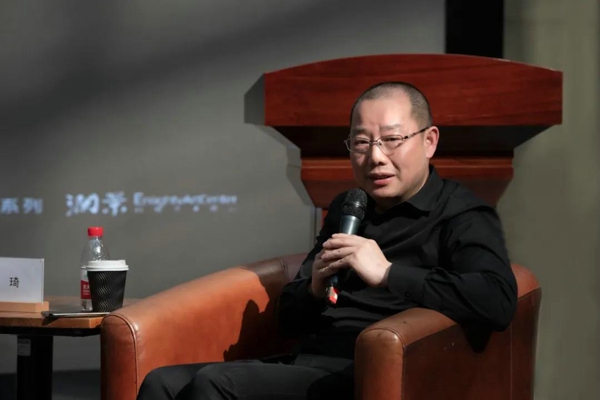
Professor Chen Qi delivering a speech
Professor Chen Qi pointed out that changes in tools and media will definitely expand the room for artists to express themselves, from the perspective of artistic development. Nowadays, computers and networks have become extended expression media for artists. For example, people born in the 60s and 70s learned to use paper media at first, but children born after the 2000s are more familiar with reading on screen. This is the change in media. Artists demand for constant self-denial and self-expression, and this demand is actually extending. On the other hand, academic imagination is also highly valued in the scientific community, so the expression of artists will stimulate science to find new media and new ways of expression. Nowadays, plenty of special effects software used in the film and television industry is based on the performance of film art, and computer experts and artists are actually partners. According to Professor Chen, artistic creation and scientific technology will cooperate in the three main directions. Firstly, we must learn new media and use new tools to expand horizontally beyond conventional creation; secondly, we must explore the characteristics of new tools and new media and find unique expression languages that are different from those of traditional media based on the characteristics of the new tools and new media; thirdly, the expression needs of artists can give birth to new forms of art and are inseparable from the invention of new media, new technologies, and new tools. Therefore, Professor Chen believed that art and technology can never be separated.
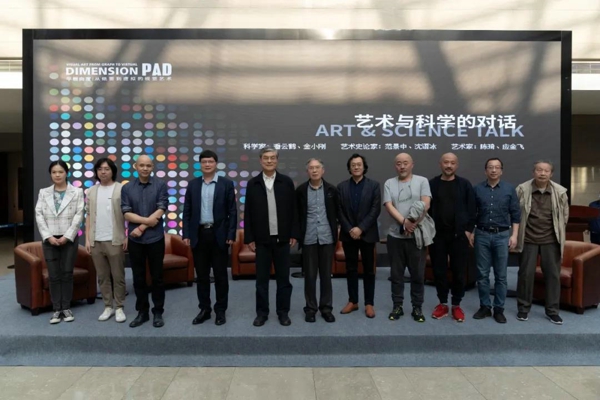
A group photo of guests and artists attending the opening ceremony
This academic exchange in the form of a cross-border dialogue between art and scientific technology, from both theoretical and practical perspectives, explores the composition and paradigm of science and humanities as two major systems beyond the passage of time and outlines the consensus principles organized by cultural logic, morality and ethics and their many examples in the process of human development that enable the integration of art and scientific technology to be better accepted and perceived by the audience in the new contemporary context. Curator Ying Jinfei summarized the purpose of the exhibition at the end of the dialogue. He said that “Pad Dimension” actively connects art with technology for co-existence with its forward-looking vision and avant-garde spirit in today’s digital age and is an exploratory practice for ZJAM to aim for the next century. It was convincing that this exhibition can not only reveal many possibilities from the integration of scientific technology with art, but also repay the society and help to explore the close connection between reality and virtuality in the digital reform. It would undoubtedly become an “important window” for the future development mode of art and the growth forms of scientific technology.
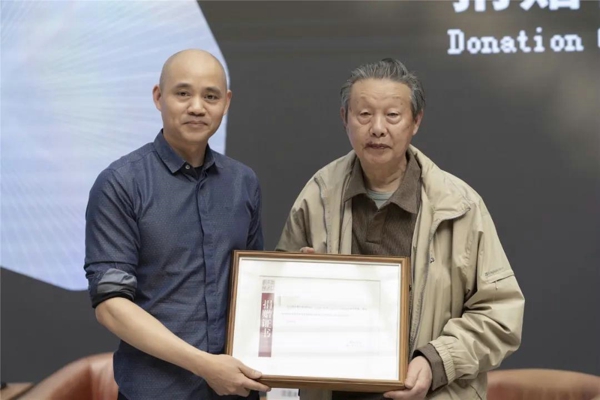
Curator Ying Jinfei presenting a donation certificate to the artist representative Mr. Qian Guisun
This exhibition was strongly supported by many artists who donated their exhibited works to ZJAM. At the opening ceremony, Curator Ying Jinfei presented a donation certificate to the donating artist representative Mr. Qian Guisun, to thank the artists for their important contributions to the contemporary collection system of ZJAM.
 Tel: 0571-87078700 | Site Service:0571-87078700
Tel: 0571-87078700 | Site Service:0571-87078700 Address: NO.138 Nanshan Road Hangzhou Zhejiang
Address: NO.138 Nanshan Road Hangzhou Zhejiang Opening: Tuesday to Sunday 9:00am-5:00pm, Closed Mondays
Opening: Tuesday to Sunday 9:00am-5:00pm, Closed Mondays















